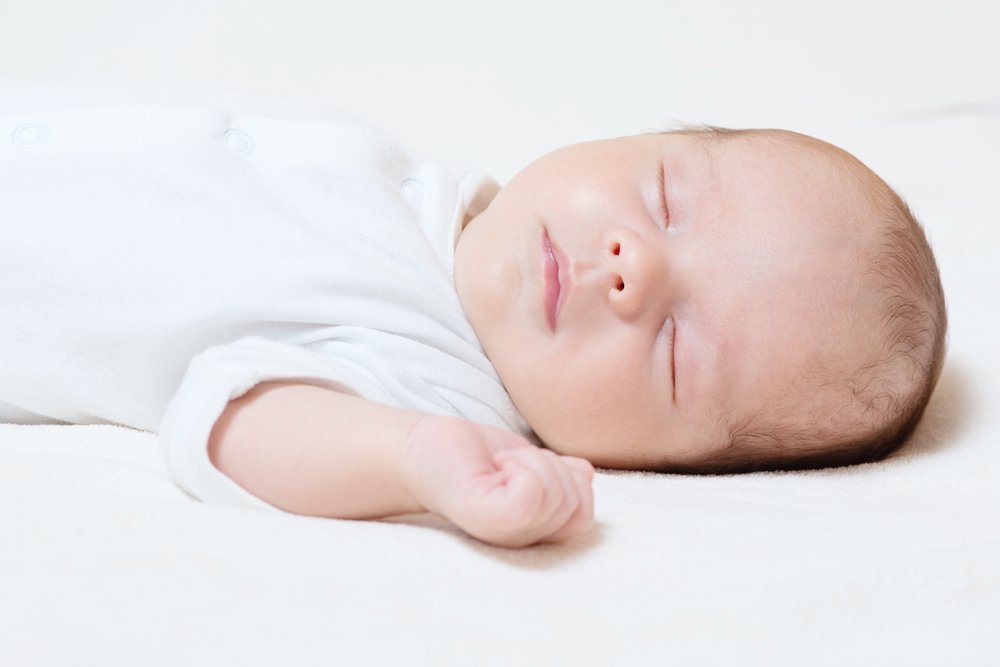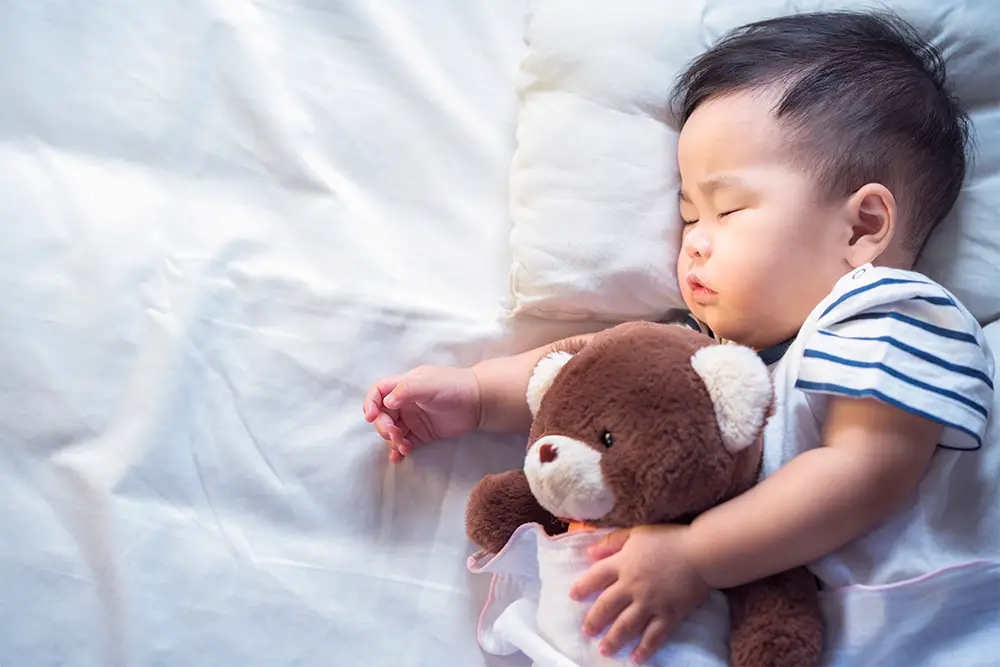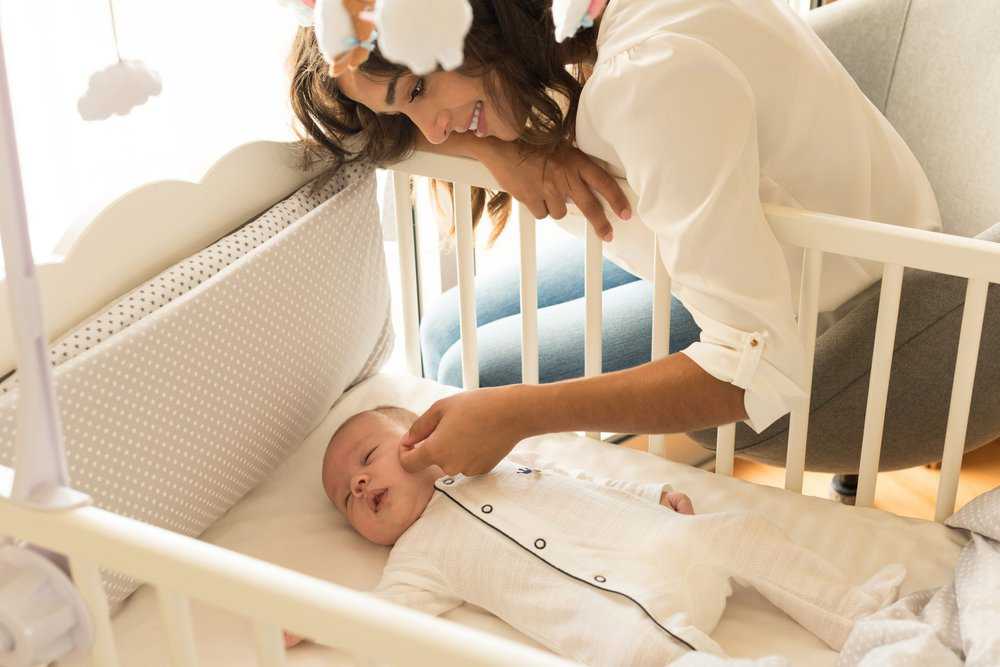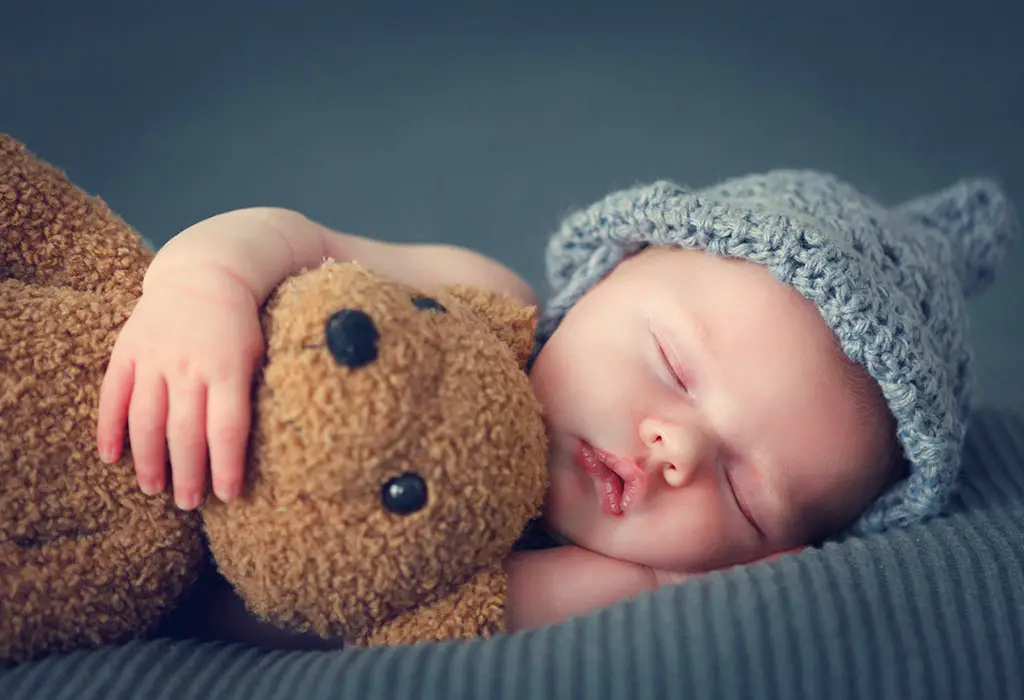Like a sweet little angel, your baby falls asleep in your arms or chest. You lower them into their crib as gently as possible. But, of course, they begin crying immediately – even before they feel the mattress beneath them. And it appears that nothing can stop the crying except picking them up and holding them again to repeat the cycle. Does this sound familiar?

Many new parents find themselves in this situation early in parenting. And when you’re sleep-deprived and tired, all you want is for your baby to stop crying and sleep for a few hours. But there is some promising news: it is possible to put your baby to sleep without holding them and to teach them to sleep independently so that your entire family can begin to sleep soundly. So, how to get your baby to sleep without being held?
It’s naturalistic for a newborn to want to sleep in your arms, but it’s also critical to learn to fall asleep on their own before it becomes a habit. You can use gentle techniques with your baby to teach them to sleep without being held or rocked. It is critical to teach your newborn to sleep independently for their safety and to ensure that you get enough sleep. Read on to know more about how to get your baby to sleep without being held.
How to get your baby to sleep without being held? Why won’t they sleep without being held?
There are several reasons why many babies, particularly newborns, will not sleep unless they are held. Some of the probable causes are:
- Babies want to be near you
It’s natural for newborns to desire the warm coziness they feel when resting in your arms or chest after spending nine months safely curled up in the womb. All babies require being held to feel safe and connected to their caregivers. So, why and how to get your baby to sleep without being held? When your baby refuses to sleep unless held, this has become a habit you must break.
- Babies go through a lot of physical changes and require parental comfort
Babies go through a lot of changes, both physically and in their surroundings. This input can be overwhelming at times, especially for newborns. Babies require sleep to recover from physical discomfort or excessive stimulation. Otherwise, you risk an overtired baby, which can lead to other sleep issues. In times of transition, they may find it comforting to be held while sleeping.
- Sleep is associated with being held by your baby
If you’ve allowed your baby to sleep in your arms since they were newborns, they’re likely to associate the sensation of being held with sleep. If your baby cannot sleep for more than a few minutes without being held, you will need to gradually change this association so they can fall into a deep sleep on their own. So, why and how to get your baby to sleep without being held? Read on till the end to find out.

How to get your baby to sleep without being held?
While sleep-deprived new parents may find it difficult to believe, there are strategies you can use to help your baby learn to sleep without being held. It is critical to teach your newborn this skill.
While it’s adorable to hold your sleeping baby in your arms in the early days, it’s not safe to do so regularly. If you fall asleep while holding them, you may drop your baby. Because of the risk of suffocation, adult beds are unsuitable for infants. To reduce the risk of SIDS, babies should sleep in a crib or bassinet in their room for the first six months.
If your baby doesn’t sleep unless he or she is held, try out the recommendations below:
Put your sleepy but awake baby down
We’re all creatures of routine and ritual, getting used to doing or experiencing what we’ve always accomplished or experienced. If your newborn has always fallen asleep in your arms, it’s no surprise that he cries when he sleeps in any other position.
The first step in breaking those habits and sleep associations is to put him to bed drowsy but awake. That way, he’ll be able to practice falling asleep away from your arms, and in the sleep environment, he’ll eventually awaken.
After all, few of us can fall napping in one place, be transferred to another, and not wake up. The same holds true for your child.
They’ll also realize that they don’t need to be held to fall asleep. Again, they become so accustomed to falling asleep in your arms than any other method feels strange. By putting them down drowsy but awake regularly, they learn that it is also acceptable to fall asleep in this manner.
Sure, hold them in your arms, but once he begins to drowse, place them where you want them to sleep so they can witness the transition.
Allow your newborn to sleep in a relaxing location
Babies seek refuge in small spaces after spending so much term in the womb. While the crib is the perfect place to position your baby, many parents have had better luck in other, more intimate places. These provide the secure feeling of being “cupped” and held in your arms. Here are a few suggestions:
- Baby bouncer
- Baby cushion
- Wrapping a baby
- Suit for sleeping
- Swaddle

Warm up the crib mattress
How to get your baby to sleep without being held? Your baby may struggle to adjust from your warm, cozy arms to a cold, hard crib.
To make the bed even more inviting, place a heating pad or a warm bottle on the crib a few minutes before you intend to put them down. Of course, make certain that the bed is not too hot. Another option is to raise the temperature in the room before putting them down, so they don’t get too cold. Easing them out of your arms can feel cozy if you keep their crib warm.
Stroke your child’s face
Are you concerned that your baby will startle and cry when you put them down awake?
How to get your baby to sleep without being held? To help them relax, try this simple trick: stroke their cheek and forehead until their eyes close after putting them down awake. You might stroke their brows or run your finger from the bridge of their nose to the top of their head. Stroke their cheeks politely from nose to ear.
These easy touches may be all required to keep them tired until they fall asleep. Sure, they still require your assistance to sleep, but at least you’re not holding them the entire time.
After putting your newborn down, keep your hands on them
That contact with your body, the warmth on their chest as it presses against yours, is one of the sensations of being held. But once you put them down, the warmth fades, leaving them vulnerable.
How to get your baby to sleep without being held? To simulate that caregiving sensation, try the following trick to make the transition easier:
- Place them down before they fall asleep, but keep your cradling arm wrapped around their body and your other hand on their chest. If you can, keep your chest lightly touching them as if you’re still hugging and holding them lying down.
- Then, as they fall asleep, slowly lift and slide your cradling arm from beneath them while keeping your other hand on their tummy. Finally, take away the other hand so that they can sleep alone.
If your newborn is fussy, use a pacifier
How to get your baby to sleep without being held? You may notice fussiness as you lay your sleepy baby down. If they like pacifiers, now is the time to put one in their mouth to encourage sucking. Instead of waiting until they start crying hysterically, insert the pacifier as soon as you notice them fidgeting or becoming upset.
Then, while keeping the pacifier in his mouth, keep your hand on them, so he still feels you. This will remind them of your presence while encouraging them to suck on the pacifier and sleep.
Keep the pacifier in their mouth after you’ve gone. However, if you notice your newborn squirming again (or you suspect they’re about to wake up), use the pacifier again:
- Replace the pacifier if it has fallen out of their mouth.
- If the pacifier is still in their mouth, gently “tug” it out. This will motivate them to suck harder and, hopefully, sleep longer.

Make use of white noise or music
Having the room completely silent invites unexpected noises that will wake your baby. Instead, muffle those sounds with white noise. They will not only block those sounds, but they will also remind your child of the constant hum he/she heard while in your womb.
How to get your baby to sleep without being held? You could employ an app or purchase a white noise machine. Perhaps you download and loop a static music file on your phone or turn on a standard fan or heater. After you put them down, the white noise will add a constant hum to encourage continuous sleep.
Some parents have also taught their babies to associate soothing music with sleep.
Play music while nursing at night to help him associate it with comfort and drowsiness. Then, as you lay him/her down and put him/her to sleep, keep the music playing. We hope they’ll fall asleep with the music still playing nearby. Add darkening curtains to his room to keep it completely dark.
Create a bedtime routine
How to get your baby to sleep without being held? Create a consistent bedtime routine. Bathing, reading, and singing are examples of quiet activities that will not overstimulate your baby. Play music softly. Your routine should conclude with a signal to your baby that it is time for you to leave the room and for them to sleep.
Also Read: How To Play Pop It Game Plus 4 Fun Alternatives!
How to get your baby to sleep without being held? Should I Put My Baby to Sleep Training?
When their baby isn’t sleeping or wakes up frequently at night, many parents are inundated with guidance from everyone around them about sleep training methods. However, for new parents, the concept of sleep training can be overwhelming.
Simply put, sleep training is a set of techniques to help babies sleep independently. They include gentle methods such as the Pick Up Put Down method, which entails shushing and patting your newborn’s back until they sink into sleep in their crib and then coming back to them and even picking them up if they wake up as many times as necessary. However, they include more structured techniques such as the Ferber method and crying it out.
Not every strategy will function for every parent or child when it comes to sleep training your baby. The American Academy of Pediatrics suggests pausing until your baby is four to six months old before endeavoring sleep training. They’re out of the budding stage, have more uniform naps, wake up less for night feedings, and are developmentally ready.
How to get your baby to sleep without being held within seven days?
Sleepless nights appear like a small price to pay in the early days of life with a newborn because you’re focused on what’s best for the baby. However, by week six, waking up every few hours becomes tiresome. You may pretend to sleep by month three, hoping your partner will get up first and fetch a bottle. Nevertheless, you may forget to feel what not being tired is!
The good news is that if you let them, most babies start sleeping through the night without being held. So, how to get your baby to sleep without being held? The key is to develop solid sleeping habits that will last for years. A seven-day plan can help you and your baby gets a good night’s sleep without being held.
Day 1: Establish a Routine
Many babies confuse their days and nights, sleeping for long stretches in the afternoon and waking up to play at bedtime. However, this method will correct this. According to new research, infants can be taught the difference between night and day from birth. All you have to accomplish is supply the cues that allow this to happen. Here are some things you can do:
- On the first day, get your baby up early.
- Attempt to get up at the same time every day.
- Place your baby’s crib near a window to allow natural light to enter. (Just make sure there are no blinds or drapes that could be a hazard.)
Natural light aids in the organization of babies’ circadian rhythms. Allowing them to nap in natural light can also help this process. When they wake up from a nap in the middle of the day, they know it’s time to get up. If they are awake in the dark in the middle of the night, they will learn to go back to sleep.

Day 2: As they say, practice makes perfect
On day two, concentrate on establishing the consistent routine you started on day one. If your child still needs nighttime feedings, now is the time to emphasize the difference between day and night. Keep night feedings relaxing by keeping the lights low. Make every effort to avoid stimulating your baby. Make feedings a high-activity time during the day, when you tickle their feet or sing songs, so they notice the difference.
Take note of what soothes your baby in the evening as well. A bath can be soothing for one child and energizing for another. You could also experiment with white noise. Many infants respond well to the hum of a fan, air conditioner, or a radio set to static. The advantage of using white noise is that you can gradually phase it out as your baby’s sleep patterns improve.
Day 3: The Crying Begins
Prepare yourself: Day three entails placing your child in their crib while they are still awake.
It’s the most crucial thing you can do. If your newborn falls asleep at your breast during bedtime feeding, rouse them sufficiently so that their eyes are fully open when you place them in the crib. Of course, there may be some (or a lot) of crying. But rest assured, it will be more difficult for you than for your child.
Listening to their child cry can be agonizing for parents, but keep reminding yourself that the result is sleep and will benefit the entire family. Get over the fear that ignoring your crying baby will cause psychological harm. If you’ve fulfilled their every need in other ways, this situation won’t make them feel any less secure.
If a bedtime battle occurs, check on your baby and reassure them that you’re there regularly. However, keep your visits brief:
- Don’t turn on the light.
- Take them out of their crib.
- Give them a pacifier or bottle.
If they sleep with one of these crutches, they’ll beg for it when they wake up.
Day 4: Keep Going
The third day was a long one. Day four should see an improvement. Your baby will realize that crying does not produce results sooner. Increase your response time to every ten minutes when they protest. And don’t give up no matter what. If you are inconsistent, the baby learns to hold out – they will simply up the ante and cry twice as long the next night.

Day 5: The Baby Settles
Most babies adjust in three to five days, so this could be your lucky night. If your child is still capable, increase your response time to 15 minutes. Some babies require frequent reassurance that you are monitoring them, while others find it annoying.
Checking on the baby is primarily for the benefit of the parents. It’s fine to stay away if you notice that you’re exacerbating your child’s reaction every time you go in. Instead, look at them through a door crack, so they don’t see you.
Night feedings are another common issue at this point. Most infants are ready to give them up at about 12 pounds or 3 to 4 months – but you can’t just stop cold turkey with a younger baby. You can, nevertheless, keep them as concise and quiet as feasible: cuddle your baby but don’t sing to them, turn off the lights even when changing diapers, and put them in the crib as soon as they’re done, even if they’re awake.
Day 6: The Baby Sleeps All Night
Doesn’t that sound like bliss? But you’ll probably be wandering the halls anyway. You might check on the baby, but don’t worry. Dress them in warm PJs so you don’t have to worry about kicked-off covers, and turn down the monitor, so you only hear them if they’re in real trouble. Now that you’ve made so much progress don’t undo it by rushing in. Allow your child to soothe themselves. You must also relax to fall asleep!
Day 7: You also sleep well
Offer yourself a well-deserved pat on the back. Not only have you regained your sleep, but you’ve also given your baby an important gift: good sleep habits are as important to a child’s well-being as good hygiene. There will, of course, be setbacks, such as illness, a new sibling, or an unfamiliar hotel room. Even children who sleep well will occasionally have issues. However, we can fall back on our fail-safe plan whenever the need arises. Because they already know the drill, your child will respond with even less difficulty the second time.
To Conclude
So, how to get your baby to sleep without being held? We’ve discovered that a lot of it is trial and error, but it is possible to get your baby to sleep on his own.
Ensure you don’t keep your newborn awake for too long and that you put them down drowsy but awake. Allow your newborn to sleep in a warm place or warm their bed before placing them in it. As you set them down, stroke their face and keep your hands and arms around them.
Use a pacifier if they begin to fuss or wake up earlier than you would like. White noise and music can help your newborn sleep by muffled startling sounds. Finally, even if they’re awake, allow them to lie down – you never know when they’ll fall asleep.
After all, you should be able to get your baby to sleep without being held.

Frequently asked questions on how to get your baby to sleep without being held
- When do babies start falling asleep on their own?
By four months, most babies will have learned to self-soothe, making it easier to fall asleep independently. Around this time, their circadian rhythms mature, resulting in more regular sleep-wake cycles.
- Will excessively holding a baby make it difficult for them to fall asleep independently?
If you constantly hold your child until they fall asleep, they will associate sleeping with being held, making it difficult for them to learn to sleep without being held. You should also be aware of your baby’s cues. Rather than holding your baby, try putting them down and soothing them by patting or rubbing their back.
- When do babies start napping through the night?
It is not uncommon for a newborn baby to have irregular sleeping patterns. Many babies are awake every three to four hours during the day and evening for the first months. Most newborns do not develop a consistent sleep pattern until they are three to six months old when they will start sleeping through the night. So, if you’re having trouble getting your newborn to sleep on its own, remember that it may take some time before your baby sleeps in a regular pattern.
- Will my baby always sleep through the night if I sleep train them?
No, not always. What works for your baby at one stage of life may not work at another. Your child’s sleeping habits will evolve as they grow. Newborn babies require significantly more daytime sleep than older babies. Additionally, your baby will experience teething, illnesses, and growth spurts, disrupting their sleep. However, if your baby suddenly stops sleeping through the night and starts waking up every two hours, try changing your routines and consulting your doctor.

